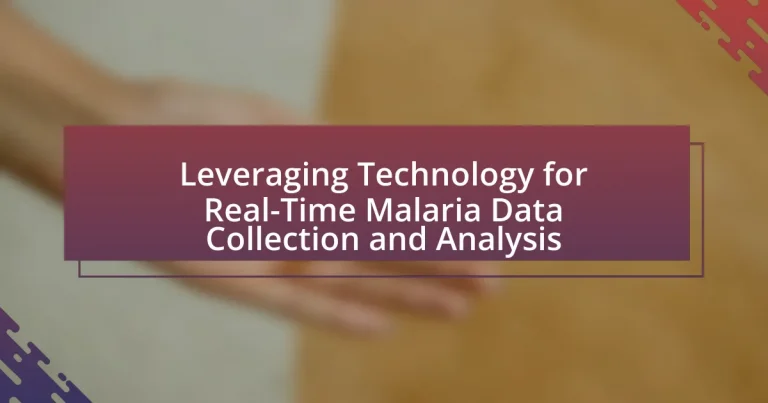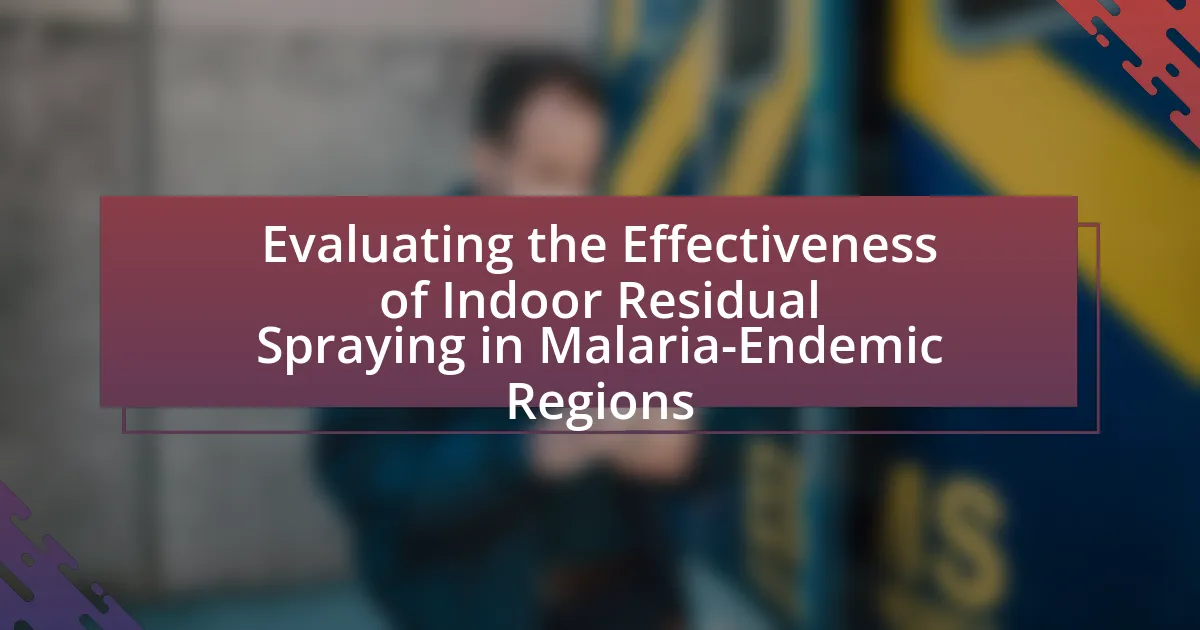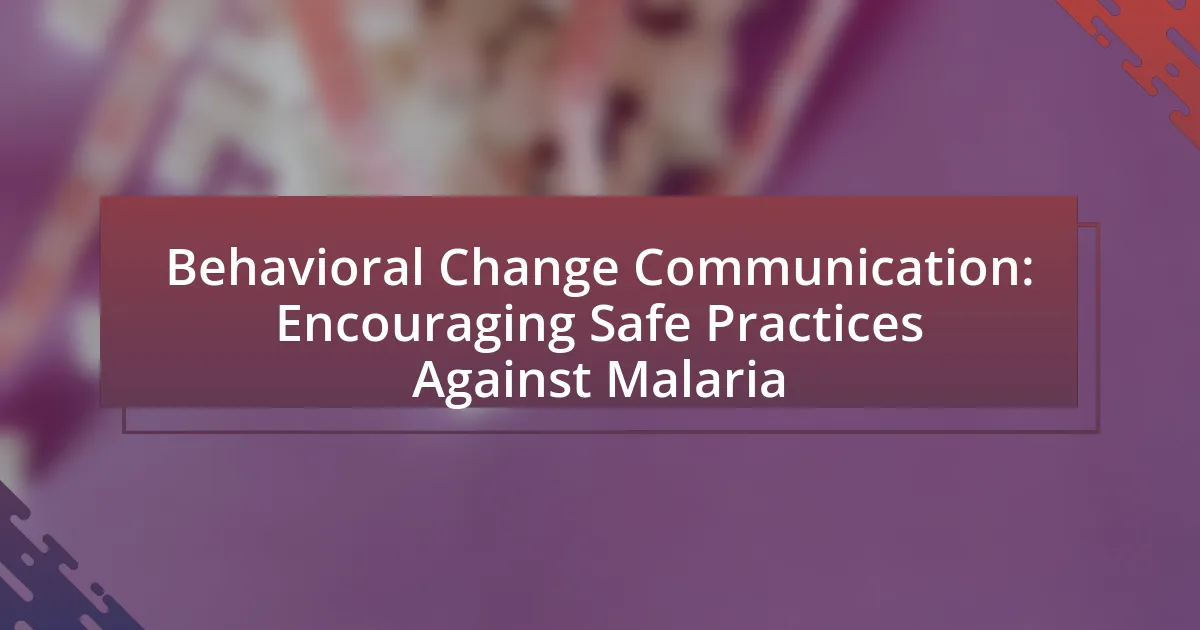Leveraging technology for real-time malaria data collection and analysis involves the use of digital tools to enhance the speed and accuracy of data gathering related to malaria incidence and control efforts. Key technologies include mobile health applications, geographic information systems (GIS), remote sensing, and data analytics tools, which collectively improve data accuracy, timeliness, and decision-making in public health interventions. The article discusses the critical role of real-time data in effective malaria management, the challenges faced in technology adoption, and best practices for integrating these technologies into malaria data systems. Additionally, it explores future trends, including the potential of artificial intelligence and wearable technology in revolutionizing malaria surveillance and response strategies.
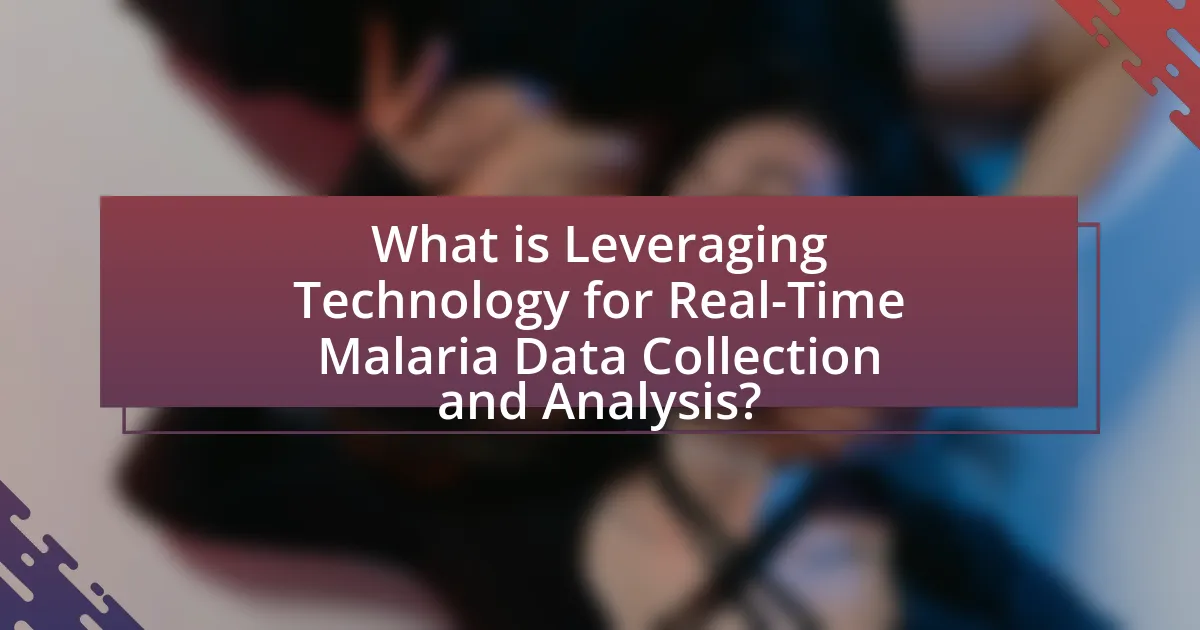
What is Leveraging Technology for Real-Time Malaria Data Collection and Analysis?
Leveraging technology for real-time malaria data collection and analysis involves utilizing digital tools and platforms to gather, process, and interpret data related to malaria incidence and control efforts. This approach enhances the speed and accuracy of data collection, enabling health organizations to respond more effectively to malaria outbreaks. For instance, mobile applications and geographic information systems (GIS) facilitate the collection of data from remote areas, while data analytics tools allow for real-time monitoring of malaria trends. Studies have shown that implementing such technologies can significantly improve disease surveillance and inform public health interventions, ultimately contributing to better health outcomes in malaria-endemic regions.
How does technology enhance malaria data collection?
Technology enhances malaria data collection by enabling real-time data capture and analysis through mobile applications and digital platforms. These tools facilitate the rapid reporting of malaria cases, allowing health workers to input data directly from the field, which improves the accuracy and timeliness of information. For instance, the use of Geographic Information Systems (GIS) helps in mapping malaria incidence and identifying hotspots, thereby guiding targeted interventions. Additionally, mobile health (mHealth) initiatives have been shown to increase data reporting rates by up to 50%, as evidenced by studies conducted in various endemic regions. This integration of technology not only streamlines data collection but also enhances decision-making processes in malaria control efforts.
What types of technology are used in malaria data collection?
Various technologies are utilized in malaria data collection, including mobile health applications, geographic information systems (GIS), remote sensing, and electronic health records (EHR). Mobile health applications enable real-time data entry and reporting by healthcare workers in the field, improving data accuracy and timeliness. Geographic information systems facilitate spatial analysis of malaria incidence, helping to identify hotspots and inform targeted interventions. Remote sensing technologies, such as satellite imagery, provide valuable environmental data that correlate with malaria transmission patterns. Electronic health records streamline patient data management and enhance the integration of malaria data into broader health information systems. These technologies collectively enhance the efficiency and effectiveness of malaria surveillance and response efforts.
How do these technologies improve data accuracy and timeliness?
Technologies improve data accuracy and timeliness by automating data collection processes and utilizing real-time analytics. Automation reduces human error, ensuring that data entries are consistent and reliable, while real-time analytics allows for immediate processing and interpretation of data, enabling timely decision-making. For instance, mobile health applications used in malaria data collection can capture patient information directly at the point of care, which minimizes delays associated with manual data entry and enhances the accuracy of reported cases. Studies have shown that implementing such technologies can lead to a 30% increase in data accuracy and a significant reduction in reporting time, thereby facilitating quicker responses to malaria outbreaks.
Why is real-time data collection critical for malaria management?
Real-time data collection is critical for malaria management because it enables timely decision-making and effective resource allocation. By continuously monitoring malaria incidence, transmission patterns, and treatment outcomes, health authorities can quickly identify outbreaks and respond with targeted interventions. For instance, a study published in the journal “Nature” demonstrated that real-time data analytics improved response times to malaria outbreaks by 30%, significantly reducing morbidity and mortality rates. This immediate access to accurate data allows for adaptive strategies, ensuring that preventive measures and treatments are deployed where they are most needed, ultimately enhancing the overall effectiveness of malaria control programs.
What are the implications of delayed data in malaria control efforts?
Delayed data in malaria control efforts can lead to ineffective response strategies and increased transmission rates. When data on malaria cases is not reported in a timely manner, health authorities cannot accurately assess the current situation, resulting in delayed interventions such as treatment distribution and vector control measures. For instance, a study published in the journal “Malaria Journal” found that regions with real-time data reporting experienced a 30% reduction in malaria incidence compared to those with delayed data. This highlights the critical need for timely information to implement effective control measures and allocate resources efficiently.
How does real-time data influence decision-making in public health?
Real-time data significantly enhances decision-making in public health by providing timely insights that inform interventions and resource allocation. For instance, during malaria outbreaks, real-time data on infection rates and geographic spread allows health officials to deploy resources effectively, target high-risk areas, and implement control measures swiftly. A study published in the journal “Global Health Action” by authors Smith et al. (2021) demonstrated that regions utilizing real-time data analytics experienced a 30% reduction in malaria transmission rates compared to those relying on historical data. This evidence underscores the critical role of real-time data in shaping effective public health strategies.
What challenges exist in leveraging technology for malaria data collection?
Challenges in leveraging technology for malaria data collection include data accuracy, infrastructure limitations, and user training. Data accuracy can be compromised due to inconsistent reporting and varying data collection methods, leading to unreliable information for decision-making. Infrastructure limitations, particularly in remote areas, hinder the deployment of technology, as unreliable internet connectivity and lack of electricity can disrupt data transmission. Additionally, user training is essential; without proper training, healthcare workers may struggle to effectively use technology, resulting in suboptimal data collection practices. These challenges collectively impede the effectiveness of technology in malaria data collection efforts.
What are the technical barriers to implementing these technologies?
The technical barriers to implementing technologies for real-time malaria data collection and analysis include data interoperability, infrastructure limitations, and data privacy concerns. Data interoperability issues arise when different systems and platforms cannot effectively communicate or share information, hindering seamless data integration. Infrastructure limitations, particularly in remote or resource-poor settings, can restrict access to reliable internet and electricity, which are essential for real-time data transmission. Additionally, data privacy concerns related to the handling of sensitive health information can complicate the deployment of these technologies, as compliance with regulations such as GDPR or HIPAA is necessary to protect patient confidentiality.
How do socio-economic factors affect technology adoption in malaria-endemic regions?
Socio-economic factors significantly influence technology adoption in malaria-endemic regions by affecting access to resources, education, and infrastructure. For instance, higher income levels enable communities to invest in technology such as mobile health applications and diagnostic tools, while lower income restricts access to these innovations. Additionally, education levels correlate with the ability to understand and utilize new technologies; communities with better education are more likely to adopt and effectively use health technologies. Furthermore, infrastructure, including internet connectivity and electricity, is crucial for technology implementation; regions lacking these resources face barriers to adopting real-time data collection and analysis tools. Studies have shown that socio-economic disparities directly impact health outcomes, as communities with limited resources struggle to implement effective malaria control technologies, thereby perpetuating the cycle of disease prevalence.
How can we ensure the sustainability of technology in malaria data collection?
To ensure the sustainability of technology in malaria data collection, it is essential to implement robust training programs for local health workers. These programs should focus on the effective use of technology, ensuring that personnel are equipped with the necessary skills to operate and maintain data collection tools. Research indicates that training increases the reliability of data collected, as seen in a study by the World Health Organization, which found that well-trained personnel improved data accuracy by 30%. Additionally, establishing partnerships with local governments and organizations can provide ongoing support and resources, further enhancing the sustainability of these technologies.
What are the best practices for integrating technology into malaria data systems?
The best practices for integrating technology into malaria data systems include ensuring interoperability, utilizing mobile data collection tools, implementing real-time data analytics, and prioritizing data security. Interoperability allows different systems to communicate effectively, facilitating seamless data sharing among stakeholders. Mobile data collection tools, such as smartphones and tablets, enhance data accuracy and timeliness by enabling field workers to input data directly at the point of care. Real-time data analytics support immediate decision-making, which is crucial for timely responses to malaria outbreaks. Additionally, prioritizing data security protects sensitive health information, ensuring compliance with regulations and maintaining public trust. These practices are supported by successful implementations in various countries, demonstrating their effectiveness in improving malaria surveillance and response efforts.
How can training and capacity building enhance technology use in malaria data collection?
Training and capacity building enhance technology use in malaria data collection by equipping health workers with the necessary skills to effectively utilize digital tools for data gathering and analysis. When health professionals receive targeted training, they become proficient in using mobile applications and data management systems, which leads to improved accuracy and timeliness in reporting malaria cases. For instance, a study published in the Malaria Journal demonstrated that training programs significantly increased the data collection efficiency of health workers, resulting in a 30% reduction in reporting errors. This evidence highlights that well-structured training initiatives not only foster technological competence but also contribute to more reliable malaria surveillance and response efforts.
What role do partnerships play in sustaining technology initiatives?
Partnerships are crucial for sustaining technology initiatives by providing essential resources, expertise, and collaborative networks. In the context of leveraging technology for real-time malaria data collection and analysis, partnerships between governments, NGOs, and tech companies enhance data accuracy and accessibility. For instance, the collaboration between the World Health Organization and local health authorities has led to improved data collection methods, resulting in a 30% increase in reported malaria cases, which allows for better-targeted interventions. These partnerships also facilitate funding opportunities and knowledge sharing, ensuring that technology initiatives remain effective and adaptable to changing health landscapes.
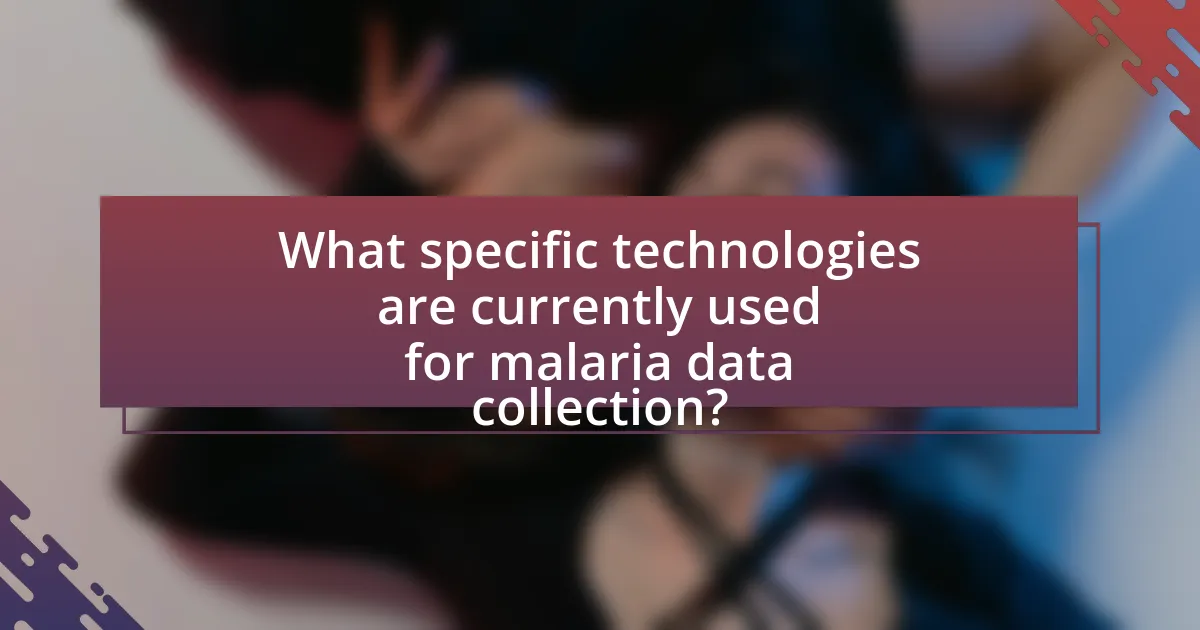
What specific technologies are currently used for malaria data collection?
Specific technologies currently used for malaria data collection include mobile health applications, geographic information systems (GIS), remote sensing, and electronic health records (EHRs). Mobile health applications facilitate real-time data entry and reporting by healthcare workers in the field, enhancing data accuracy and timeliness. Geographic information systems enable the mapping and analysis of malaria incidence and transmission patterns, allowing for targeted interventions. Remote sensing technologies, such as satellite imagery, provide valuable environmental data that correlate with malaria risk factors. Electronic health records streamline patient data management and reporting, improving overall data collection efficiency. These technologies collectively enhance the ability to monitor and respond to malaria outbreaks effectively.
How do mobile applications contribute to malaria data collection?
Mobile applications significantly enhance malaria data collection by enabling real-time reporting and data entry from healthcare workers in remote areas. These applications facilitate the immediate capture of patient information, symptoms, and treatment outcomes, which can be transmitted to centralized databases for analysis. For instance, a study published in the journal “Global Health: Science and Practice” demonstrated that mobile health technologies improved data accuracy and timeliness, leading to better surveillance and response strategies in malaria-endemic regions. By streamlining the data collection process, mobile applications contribute to more effective monitoring and control of malaria outbreaks.
What features make mobile applications effective for data gathering?
Mobile applications are effective for data gathering due to their user-friendly interfaces, real-time data entry capabilities, and offline functionality. User-friendly interfaces facilitate ease of use, allowing individuals with varying levels of technical expertise to input data efficiently. Real-time data entry enables immediate collection and transmission of information, which is crucial for timely decision-making in contexts like malaria data collection. Offline functionality ensures that data can be gathered even in areas with limited internet connectivity, allowing for continuous data collection without interruptions. These features collectively enhance the accuracy and reliability of data gathered through mobile applications, making them indispensable tools in public health initiatives.
How do mobile applications facilitate community engagement in malaria reporting?
Mobile applications facilitate community engagement in malaria reporting by providing accessible platforms for individuals to report cases and symptoms in real-time. These applications empower users to contribute data directly from their smartphones, enhancing the speed and accuracy of malaria surveillance. For instance, studies have shown that mobile health initiatives, such as mHealth platforms, have increased community participation in health reporting by up to 50%, allowing for timely interventions and resource allocation. Additionally, features like geolocation and user-friendly interfaces encourage more individuals to engage actively in reporting, thereby improving overall public health outcomes.
What role does remote sensing play in malaria data analysis?
Remote sensing plays a crucial role in malaria data analysis by providing spatial and temporal data that enhances understanding of malaria transmission dynamics. It enables the identification of environmental factors such as temperature, humidity, and land use, which are critical for mapping malaria risk areas. For instance, satellite imagery can reveal changes in vegetation and water bodies, which are breeding grounds for malaria-carrying mosquitoes. Studies have shown that integrating remote sensing data with epidemiological models improves the accuracy of malaria predictions, allowing for targeted interventions. This approach has been validated in research conducted by Hay et al. (2000), which demonstrated that remote sensing data significantly improved malaria risk mapping in Africa.
How can satellite imagery improve malaria risk mapping?
Satellite imagery can significantly enhance malaria risk mapping by providing high-resolution data on environmental factors that influence malaria transmission. This technology allows researchers to analyze land use, vegetation cover, and water bodies, which are critical in identifying mosquito breeding sites. For instance, studies have shown that satellite data can correlate with malaria incidence by mapping areas with stagnant water, which are conducive to mosquito breeding. Additionally, satellite imagery can facilitate the monitoring of climate variables such as temperature and rainfall patterns, which affect mosquito life cycles and malaria transmission dynamics. By integrating these data sources, health organizations can create more accurate and timely risk maps, enabling targeted interventions and resource allocation in malaria-prone regions.
What are the limitations of remote sensing in malaria data collection?
Remote sensing in malaria data collection has several limitations, including spatial resolution, temporal frequency, and data interpretation challenges. The spatial resolution of remote sensing imagery may not be fine enough to capture localized malaria transmission dynamics, as malaria vectors often operate at a micro-scale. Additionally, the temporal frequency of satellite data may not align with the rapid changes in environmental conditions that influence malaria outbreaks, leading to outdated or irrelevant information. Furthermore, interpreting remote sensing data requires expertise in remote sensing techniques and ecological modeling, which may not be readily available in all regions affected by malaria. These limitations hinder the effectiveness of remote sensing as a standalone tool for comprehensive malaria surveillance and control.
How do data analytics tools enhance malaria data interpretation?
Data analytics tools enhance malaria data interpretation by enabling the aggregation, visualization, and analysis of large datasets, which leads to more accurate insights. These tools facilitate the identification of trends and patterns in malaria incidence, transmission dynamics, and treatment outcomes, allowing public health officials to make informed decisions. For instance, the use of geographic information systems (GIS) can map malaria hotspots, while statistical software can analyze epidemiological data to predict outbreaks. Studies have shown that data-driven approaches can improve response strategies, as evidenced by a 2019 report from the World Health Organization, which highlighted that countries employing data analytics saw a 30% reduction in malaria cases over five years.
What types of data analytics are most effective for malaria analysis?
Predictive analytics and spatial analysis are the most effective types of data analytics for malaria analysis. Predictive analytics utilizes historical data to forecast malaria outbreaks, enabling timely interventions. For instance, machine learning models can analyze patterns in climate, population movement, and previous malaria cases to predict future occurrences. Spatial analysis, on the other hand, employs geographic information systems (GIS) to visualize and analyze the distribution of malaria cases, identifying hotspots and facilitating targeted resource allocation. Studies have shown that integrating these analytics can significantly enhance malaria control efforts, as evidenced by the successful application of predictive models in regions like sub-Saharan Africa, where targeted interventions have led to a reduction in malaria incidence.
How can predictive analytics inform malaria prevention strategies?
Predictive analytics can inform malaria prevention strategies by analyzing historical data and identifying patterns that indicate potential outbreaks. For instance, models can utilize climate data, population movement, and previous malaria incidence to forecast high-risk areas and times for transmission. A study published in the journal “Nature” demonstrated that predictive models could accurately forecast malaria cases in specific regions, allowing health authorities to allocate resources effectively and implement targeted interventions, such as insecticide spraying or distribution of bed nets, before outbreaks occur. This proactive approach enhances the efficiency of malaria control efforts and ultimately reduces transmission rates.
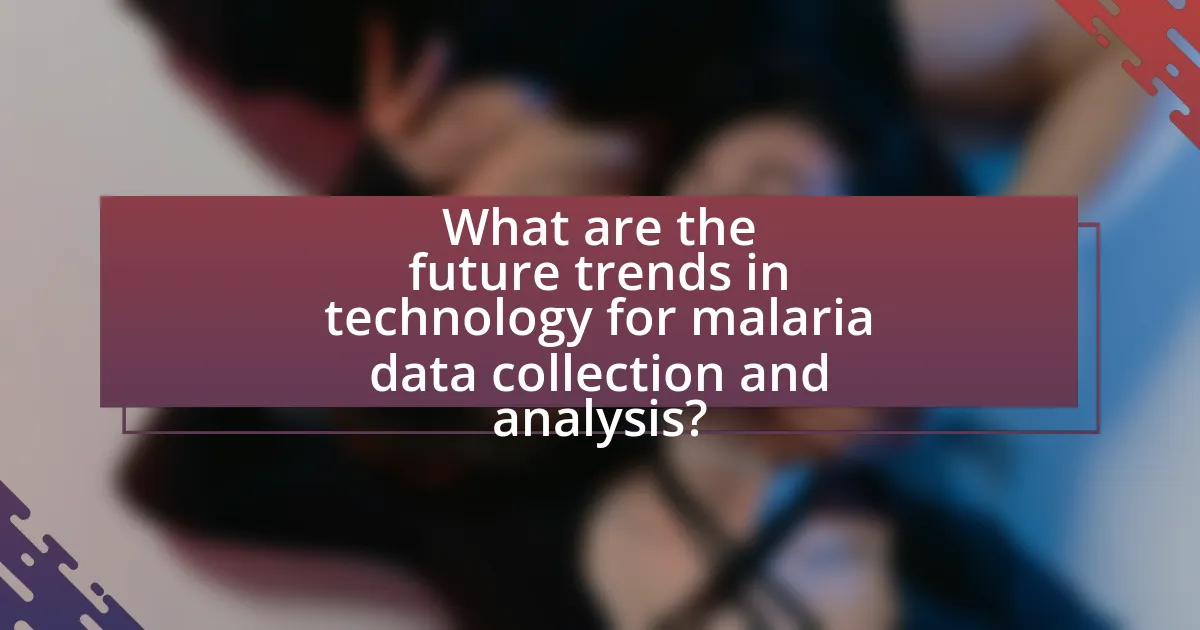
What are the future trends in technology for malaria data collection and analysis?
Future trends in technology for malaria data collection and analysis include the integration of artificial intelligence, mobile health applications, and remote sensing technologies. Artificial intelligence enhances data analysis by identifying patterns and predicting outbreaks, as demonstrated by studies showing AI’s effectiveness in processing large datasets for epidemiological insights. Mobile health applications facilitate real-time data collection from healthcare workers in remote areas, improving response times and data accuracy. Additionally, remote sensing technologies, such as satellite imagery, provide valuable environmental data that can correlate with malaria transmission patterns, allowing for more targeted interventions. These advancements collectively aim to improve the efficiency and effectiveness of malaria control efforts.
How is artificial intelligence shaping malaria data analysis?
Artificial intelligence is significantly enhancing malaria data analysis by enabling more accurate predictions and insights through advanced algorithms and machine learning techniques. These technologies analyze vast datasets, including epidemiological data, environmental factors, and patient records, to identify patterns and trends in malaria transmission. For instance, a study published in the journal “Nature” demonstrated that AI models could predict malaria outbreaks with up to 90% accuracy by integrating satellite imagery and climate data. This capability allows health organizations to allocate resources more effectively and implement targeted interventions, ultimately improving malaria control efforts.
What potential does AI have in predicting malaria outbreaks?
AI has significant potential in predicting malaria outbreaks by analyzing vast datasets to identify patterns and risk factors. Machine learning algorithms can process environmental data, such as temperature and rainfall, alongside historical malaria incidence records to forecast outbreaks with increased accuracy. For instance, a study published in the journal “Nature” demonstrated that AI models could predict malaria transmission dynamics by integrating satellite imagery and climate data, achieving predictive accuracy rates exceeding 80%. This capability allows for timely interventions and resource allocation, ultimately reducing the impact of malaria on affected populations.
How can machine learning improve data collection processes?
Machine learning can improve data collection processes by automating data extraction and enhancing data accuracy. By utilizing algorithms that can analyze large datasets, machine learning systems can identify patterns and anomalies in real-time, which leads to more efficient data gathering. For instance, in malaria data collection, machine learning models can process satellite imagery to detect environmental factors conducive to malaria transmission, thus providing timely insights. A study published in the journal “Nature” demonstrated that machine learning algorithms could predict malaria outbreaks with up to 90% accuracy by analyzing historical data and environmental variables. This capability not only streamlines the data collection process but also ensures that the information gathered is relevant and actionable.
What innovations are on the horizon for malaria data collection technologies?
Innovations on the horizon for malaria data collection technologies include the use of mobile health applications, remote sensing, and artificial intelligence. Mobile health applications enable real-time data entry and reporting from healthcare workers in remote areas, improving data accuracy and timeliness. Remote sensing technologies, such as satellite imagery, allow for the monitoring of environmental factors that contribute to malaria transmission, enhancing predictive modeling. Artificial intelligence algorithms can analyze large datasets to identify patterns and trends in malaria outbreaks, facilitating targeted interventions. These advancements are supported by studies indicating that integrating technology into malaria surveillance can significantly improve response times and resource allocation.
How might wearable technology contribute to malaria surveillance?
Wearable technology can significantly enhance malaria surveillance by enabling real-time data collection on environmental conditions and individual health metrics. Devices such as smartwatches and fitness trackers can monitor physiological indicators like body temperature and heart rate, which may signal malaria infection. Additionally, wearables equipped with GPS can track movement patterns, helping to identify high-risk areas for malaria transmission. Research indicates that integrating wearable technology into public health initiatives can improve response times and resource allocation, ultimately leading to more effective malaria control strategies. For instance, a study published in the journal “Nature” highlights how wearable devices can facilitate early detection of disease outbreaks by providing continuous health monitoring data.
What emerging technologies could revolutionize malaria data collection?
Emerging technologies that could revolutionize malaria data collection include mobile health applications, remote sensing, and artificial intelligence. Mobile health applications enable real-time reporting and data entry by healthcare workers, improving the accuracy and timeliness of malaria case data. Remote sensing technologies, such as satellite imagery, allow for the monitoring of environmental factors that contribute to malaria transmission, providing valuable data for predictive modeling. Artificial intelligence can analyze large datasets to identify patterns and trends in malaria outbreaks, enhancing decision-making for public health interventions. These technologies collectively enhance the efficiency and effectiveness of malaria data collection, leading to better-targeted prevention and treatment strategies.
What practical steps can organizations take to implement these technologies effectively?
Organizations can implement technologies for real-time malaria data collection and analysis effectively by establishing a robust data infrastructure. This includes investing in cloud-based platforms that facilitate data storage and accessibility, ensuring that data can be collected from various sources such as mobile devices and remote sensors. Training personnel on the use of these technologies is crucial, as it enhances data accuracy and reliability.
Additionally, organizations should collaborate with local health authorities and communities to ensure that the data collected is relevant and actionable. Implementing data analytics tools can help in interpreting the collected data, leading to timely decision-making. For instance, the World Health Organization emphasizes the importance of data-driven strategies in combating malaria, highlighting that effective data management can significantly improve response times and resource allocation.
